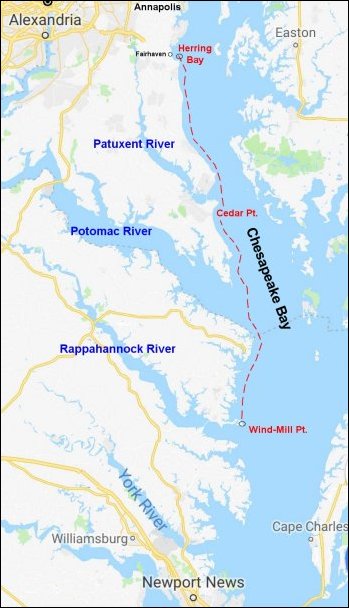
One of the last naval actions of the Civil War in
Virginia.
In spring of 1865, General Lee abandoned Petersburg and orders a withdrawal from Richmond. Lee needed a way to provide his army with supplies. A proposal was presented to capture a steamer near the Northern Neck, unload the supplies, and move them on to the Confederate army at Richmond and Petersburg.
Captain Thaddeus Fitzhugh of the 5th Va. Cavalry was selected to head up this mission.
Previously, in March of 1864 he led an expedition of 13 of his men across the Chesapeake Bay to Northampton County, Va. where he attacked the federal wharf at Cherrystone, Va. There he destroyed a large amount of commissary supplies, and the telegraph station with its submarine cable that connected Fort Monroe to Washington. He captured three vessels at the wharf: a supply schooner, the steamer Aeolas and the steam-tug Titan. He sank the schooner and bonded the Aeolas and brought the Titan safely back to Virginia.
Capture of the Harriet De Ford
Fitzhugh was ordered to capture a transport steamer laden with supplies for General Grant. Captain Sidney Smith Lee of the Confederate Navy, (brother of General Robert E. Lee and father of Confederate General Fitzhugh Lee) was selected to aid in this expedition.
The plan was to take a detail of thirty men in three open boats up Chesapeake Bay to a point just below Annapolis. To prevent detection, their movement was to be at night. If they were successful in the capture of a transport steamer, they were to proceed down the bay, seize such transports loaded with stores as they could, and then to take these to above the Rappahannock River, where two companies of Mosby's battalion and a train of wagons under charge of Maj. Robinson, of the quartermaster's department, was to distribute them to the Confederate Army.
The expedition started up the bay from Wind-Mill Point near the mouth of the Rappahannock River on March 31, 1865 and reached to Potomac River the next morning before day, where it remained for two days due to head winds. On the third night, finding wind and tide favorable, started going north again keeping so close to the shore that they could hear talking on the wharf at Point Lookout.

Fitzhugh Expedition of three days in open boats going nearly 100 miles up Chesapeake Bay to Fairhaven Maryland and the capture of the steam transport Harriet De Ford.
The next morning at about sunrise we reached Cedar Pont, near the mouth of the Patuxent River, where they learned that the transport steamer Harriet De Ford come down the Patuxent river on the next day on its way to Baltimore. The Harriet De Ford was a one-masted propeller-driven vessel – length 115.6 feet beam 19.3 feet and draft 7.1 feet. She was filled with stores from the government farms along both sides of the Patuxent and would be docking at Fairhaven, Maryland, about 14 miles south of Annapolis, to pick up more passengers and supplies for General Grant’s Army.
They sailed and oared through the night and reached Fairhaven the next morning. As soon as the De Ford landed, Fitzhugh and nine men went on board and procured passage for Baltimore under guise of wood-choppers. As the De Ford made its way up the bay, its captain was forced to surrender the boat (April 5th). The boat was turned around and returned to Fairhaven. All non-combatants and some of the De Ford crew were landed onshore and paroled. Some of black crew on board were retained. The remaining members of the Fitzhugh expedition came along side, and boarded, armed with muskets, etc. They cut the telegraph line to give themselves more time to escape.
Fitzhugh learned later on that day of the capture of Petersburg and the fall of Richmond from the captain of the De Ford and knowing Gen. Lee had changed his base of operations, the fruits of the mission were now considered useless. Fitzhugh now hastened down the bay hoping to get back to Lee’s army as fast as possible.
They reached Dymer Creek, a few miles north of the Rappahannock, the next morning about daylight, when were pushed up the river as far as we could go. They ran aground several times and had to throw some of the De Ford’s cargo overboard. On landing, they removal from the boat all valuables with the help of neighborhood farmers and a part of the machinery and a gun (a brass pivot gun). They then set fire to the steamer and burned it to the waters' edge.
That morning (April 6, 1865) at about 7:50 a.m., four gunboats of the North Atlantic Blocking Squadron that had been perusing the De Ford entered Indian Creek about a mile and a half to the north of Dymer Creek. They were the Commodore Read, a converted New York ferryboat; the Coeur De Lion; the Thomas Freeborn and the Heliotrope. The latter three vessels were of shallow draft and could bring an armed presence to the headwaters of the creek. Official Records state the Heliotrope drew about as much water under her bow as the Harriet De Ford.
The Commodore Read was somewhat limited by its 13.2-foot draft and according to her logs went about 5 miles up Indian Creek (?). She was initially lead up the creek by the pilot of the Heliotrope who signaled by whistle the depths she was encountering. After 15 minutes, the Commodore Read was forced to anchor and the Thomas Freeborn, Coeur De Lion and the Heliotrope continued up the creek. All of these vessels shelled the woods and nearby houses as they slowly went up and down the Creek. The Read opened fire at 12:40 and shelled with her guns “the surrounding woods”. From contrabands coming aboard, the Read’s captain learned that the Harriet De Ford was in Dymer Creek. The Read immediately recalled all of the fleet by whistle and he sent the Coeur De Lion and Freeborn ahead to Dymer Creek. The Read was slowly lead out of Indian Creek by the Heliotrope. The Commodore Read expended 39 shells of various types in Indian Creek.
The Thomas Freeborn entered Dymer Creek first at 12:25 p.m. and discovered the grounded Harriet De Ford being looted and burned to the waterline. The Freeborn launched three of her boats and engaged Fitzhugh’s small force and some locals. The rest of the fleet entered at about 3:00 p.m.. As before, the Heliotrope lead the Commodore Read into the Creek. She anchored at 3:10 and opened and shelled into the woods in the vicinity. She fired a total of 39 shells of varying types. To make the destruction of the Harriet De Ford complete, all three of the shallow draft vessels fired into the remains of her boiler. The captain of the Commodore Read reported the De Ford’s black crewmen were seized by rebel guerrillas and sold at auction in nearby Kilmarnock, Virginia.
Recovery of property captured on the steamer Harriet De Ford
On April 14, the Heliotrope and another shallow draft gunboat the Stepping Stones returned to Dymer Creek. Sends a boat with 30 men ashore. They retrieved one anchor and 30 fathoms of chain from the wreak.
On April 22, The Putnam retrieved the boats of the De Ford.
On April 29, the Commodore Read reported that she had recovered the deck gun from the De Ford. it was a brass 6-pounder trunnioned piece, with the name “H. De Ford” on the reinforce. It was sent to the steamer’s owner Benjamin De Ford of Baltimore.
On May 17, the Heliotrope retrieved as much of the machinery of the De Ford that was salvageable. He also reported that he recovered a considerable amount of the ship’s furniture in possession of the family of Captain Henderson who was to deliver it to a blockade runner.
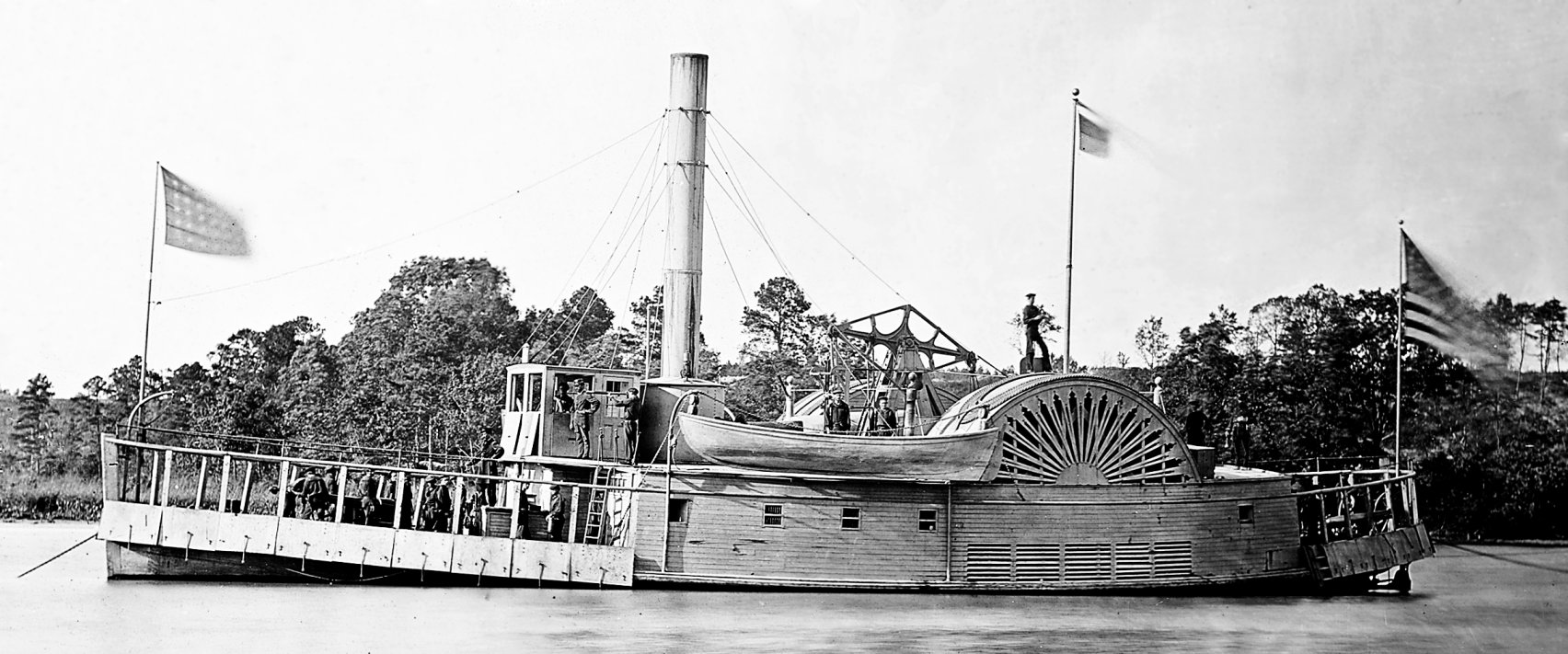
Gunboat Coeur De Lion: 4.2-inch (30 Pounder) Parrott Rifle (pivot) on the bow deck and 4.62-inch (12 Pounder) Dahlgren SB Boat Howitzer with Boat Howitzer Carriage and 3.4-inch (12 Pounder) Dahlgren Rifle on the stern deck. Iron plates on bow, stern decks and wheel house were raised to prevent incoming fire from shore. She had been the U.S. Lighthouse Service tender Van Santvoort and was transferred to the Union Navy in 1861.
The Fragment
The fragment was obtained from Jeff Chase who lives along
Dymer Creek. He plowed it up in the fields on his family farm many years ago.
Initially the shell was unexploded but for safety reasons Mr. Chase had it
detonated. A piece of the shell was given to the author via his wife after Mr.
Chase found out of his interest in Civil War history.
The fragment is about fist-sized. Its exterior has a rough convex shape with
casting lathe marks. The concave interior of the shell is smoother and was a
repository for the exploding powder that would have been set off by the shell’s
fuse. The shell has a wall thickness of about 1 inch. White arrows in the
pictures below indicate the direction of the fuse hole of the shell. The fuse
hole was not present on the fragment.

According to Mr. Chase, the shell was found on the south side
of Dymer Creek about 300 yards east of an unnamed cove that drains into the
Creek near Pembroke Road.
The lathe marks on the exterior of the fragment indicate a direction perpendicular to the long dimension of the shell and the best place to estimate the caliber of the shell. Two points along the lathe direction were selected and arc and chord measurements were made between the two points. The data was input into a smartphone application called ArcCalc. The author has written about the method elsewhere.
The results are shown below the radius was calculated to be 3.219 inches and the diameter or caliber of the shell was twice this value or 6.438 inches.
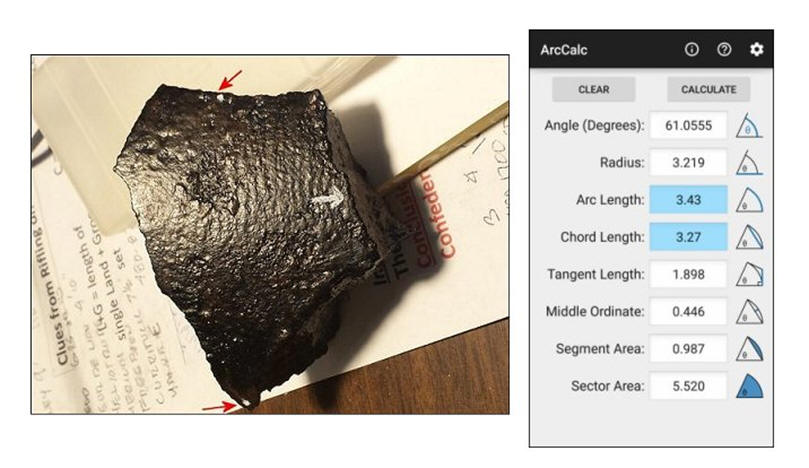
Fragment showing measurement points white dots (red arrows) along turning marks (striations) on projectile exterior casting. Measurement points on fragment are parallel to these lathe marks. Projectile was turned and cleaned of casting debris on their surface and trued to correct size on a metal lathe. White arrow indicated probable fuse location direction. Results of ArcCalc calculation (right) of radius of projectile from its arc and chord lengths between white dots. Diameter or caliber of projectile was estimated at 2 x 3.219 inches or 6.438 inches.
The above diameter calculation indicates the projectile was fired from a 6.4-inch 100 Pdr. Parrott rifle (Model 1861) and of the vessels on Dymer Creek, only the Commodore Read had that weapon type.
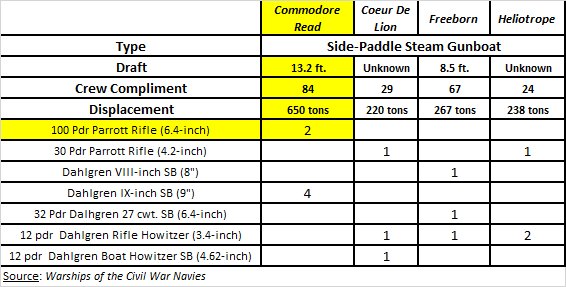

Why didn’t the shell found on the Chase’s farm ignite? It was probable a combination of a low impact angle and the type of fuse used in the Naval 100 Pdr. shell. Initially, naval rifle shells used a percussion fuse designed by Parrott. The Union Navy became concerned by the large number of Parrott Rifle barrel burstings and premature shell explosions. In 1863, Admiral John A. Dahlgren ordered the replacement of Parrott percussion fuses with Schenkl percussion fuses that like the Parrott incorporated an internal slider with a percussion nipple onto which a fulminate of mercury-filled common percussion cap was placed. On striking the target the slider moved forward and struck the anvil head of the fuse and the percussion cap discharged down the central tube of the slider, igniting the main charge of the shell.
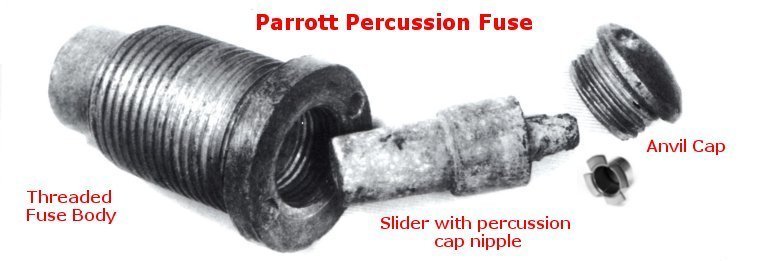
The new percussion fuse had several safety features that the Parrott fuse lacked. First, a small brass screw was threaded through the side of the fuse body and into the slider to prevent any pre-ignition of the fuse. The screw was sheared off during firing only if the fuse met with considerable resistance (Abbot). The second feature was a reversible anvil cap with a cavity on one side that denied the slider’s recessed percussion nipple an impacting surface. During firing, the anvil cap was reversed to its “flat” or “firing side”. This allowed the percussion cap to discharge on impact against the anvil cap and send a small flame into the main powder charge through a tube running down the center of the slider.
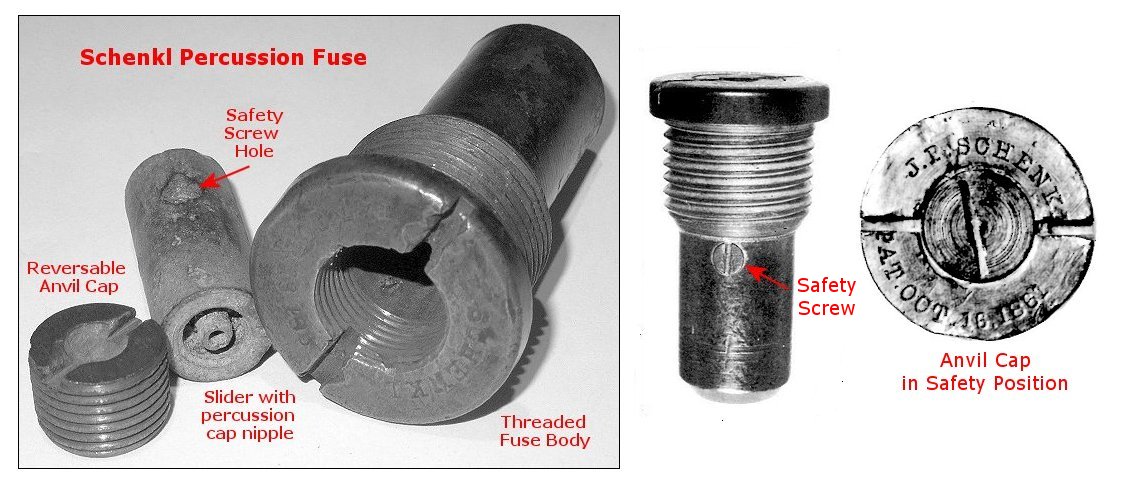
According to the Ordnance Instruction for the United States Navy (1866) The best fuse for rifle-guns was the percussion fuse: “Time-fuses are very unreliable in rifle-guns; expanding projectiles [those with sabots] cut the flame from the fuse… The best effect of a percussion-fuse is obtained by firing into a mass of timber. They frequently fail if fired into a bank of soft earth, sand, or other material which does not offer a sufficiently sudden resistance; also, if fired at high angles of elevation, owing to the fact that the rifle-shells do not generally strike point foremost…..They frequently fail to explode the shell at long ranges, owing to the shell not striking on its apex.”
From the ship’s logs on firing shells on Dymer Creek:
Coeur de Lion: “… arrived at the creek in the company of the Commodore
Read, Freeborn, and Heliotrope, shelling the woods both sides as we went
along.”
Commodore Read: “..anchored; opened fire and shelled the woods in
the vicinity”
Thomas Freeborn: “…steamed down Dymer Creek, shelling the woods on
both sides.”
This indicates that the gunboats in Dymer Creek were
probably using percussion fuses in their 100 Pdr. Parrott Rifles. The
gunboats were using “suppressing fire” to prevent hostile fire from the shore.
If Parrott shells landed at a low angle of impact into soft soil like a farmer’s
fields, the fuse would not be able to ignite the shell. This is probably what
happened to the shell falling on the Chase farm.
Civil War Artillery expert Peter George has also observed
that about one in four Parrott shells did not explode. Of the 110-large caliber
Union cannon that cracked or burst in action during the war: 60 or 55% were
6.4-inch Parrotts.
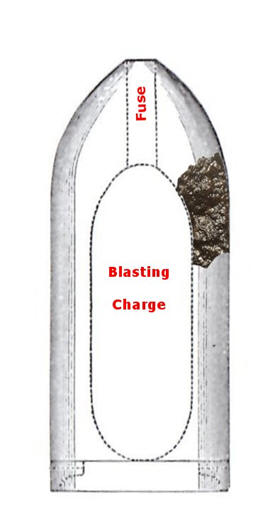
US 6.4-inch Parrott Type 2 Short Shell outline with fragment superimposed.
The location of the blasting charge set off by the Schenkl Percussion fuse.
Diameter of Shell: 6.33 inches; Length: 15.75 inches; weight 80 pounds.
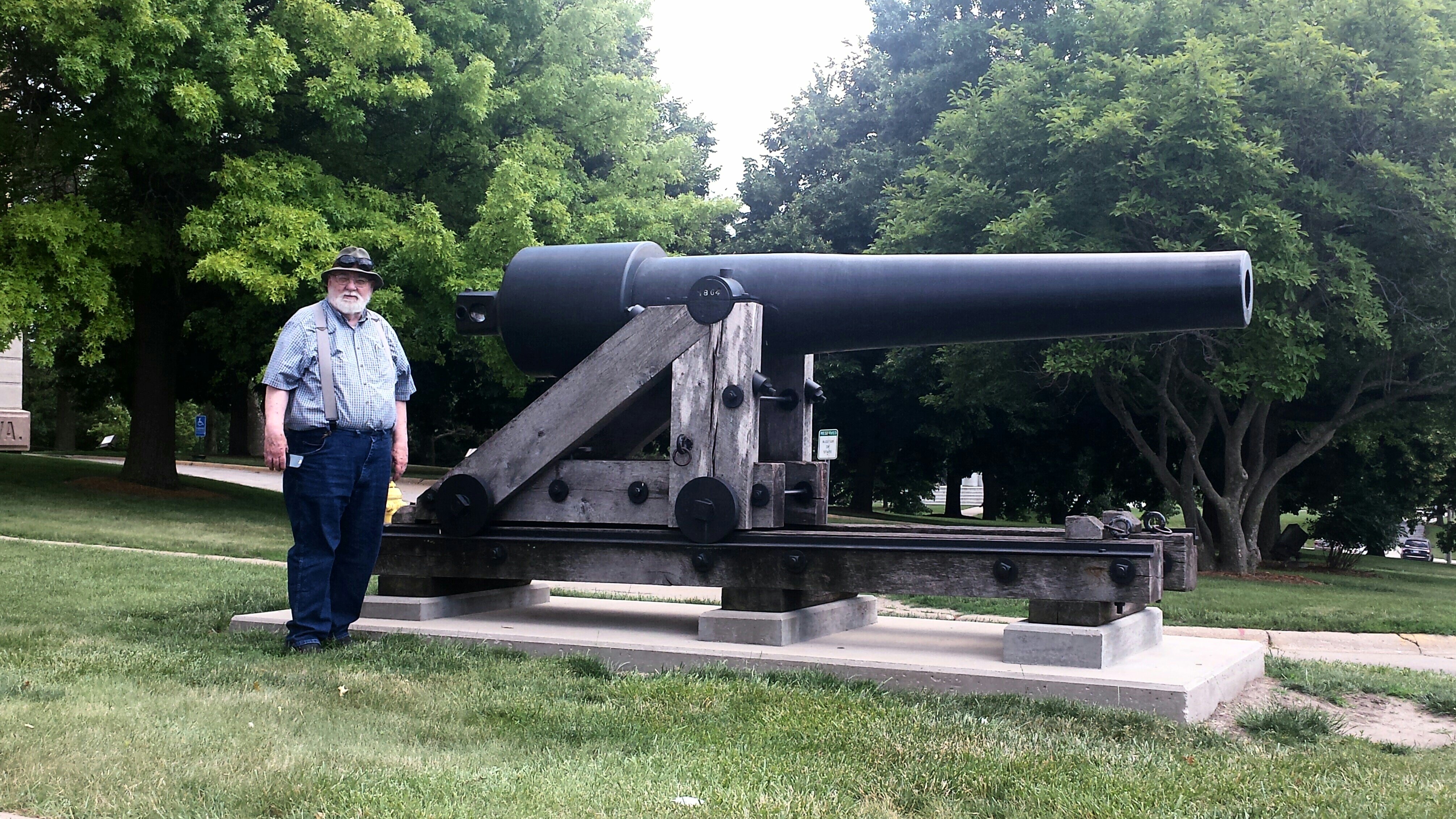
Author with Naval 100 Pdr. 6.4-inch Parrott rifle. Rifles like this would have
been the pivot gun on the bow and stern decks of the Commodore Read.
The pivoting carriage and rifle weigh a total of 9,727 pounds.
Firing Solutions and Steaming Assumptions
Where was the Commodore Read when it fired the shot
that landed in the Chase’s field? The ships logs indicate when the gunboats
entered Indian and Dymer creeks. and when they anchored. Several firing
positions are possible in Indian Creek and several in Dymer Creek. The
Commodore Read first entered Indian Creek at 12:05 and it anchored at 12:20.
It followed the Heliotrope into the Creek. The Heliotrope was a
6-knot vessel (6.9 miles per hour). Assuming that she traveled at 4-knots (4.6
miles per hour) in order to relay the water depth to the Commodore Read,
the Read would have traveled about 1.15 miles (2024 yards) at this speed
from where it entered the Creek in 15 minutes or just north of Long Creek.
Picking the entry point to either Indian or Dymer Creek is unknown. (See blue
star on map below).
The shot from Indian Creek would have been toward the woods
to the south side of the creek. Assuming an over-shot of the woods, the range to
the Chase’s farm would be about 1800 yards at a rifle elevation of 5 degrees and
the angle of impact at the farm would have been 5 ¼ degrees.
Perhaps a better firing solution is found in Dymer Creek. There the Read entered the creek at 3 p.m. following the Heliotrope at 4-knots and she anchored at 3:10 p.m. having traveled 1355 yards (0.77 miles). The entry point into Dymer Creek is still problematic.
The shot from Dymer Creek (blue star on map below) would have been down the creek at a range of 1000 yards to the farm and the angle of impact was 2.73 degrees. Both of these firing solutions would have resulted in a non-exploding shell on low-angle impact into soft loamy soil of the Chase Farm. The lack of resistance of the farmland to the impact of the shell probably prevented the small brass screw on the side of the Schenkl fuse from being shear off on impact, rendering the fuse and the shell inert.
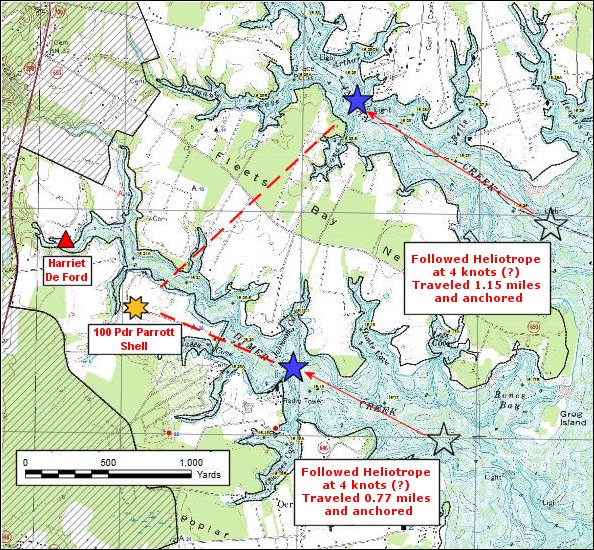
Epilogue – Timeline of 12 days
April 3rd, North Atlantic Blocking Squadron was informed about the capture of Richmond. Fitzhugh Expedition reached Fairhaven the next day.
April 5th, Fitzhugh learns of the capture of Petersburg and the fall of Richmond from the captain of the De Ford.
April 3-7th, President Lincoln visits General Grant and views ruins of
Richmond and Petersburg and their battlefields. April 6th, federal
gunboats enter Indian Creek and that afternoon enter Dymer Creek and find the
De Ford burned and looted. Thomas Freeborn crew engages Fitzhugh
expedition members and local farmers.
April 7th, Grant asks Lee to surrender.
April 9th, Lee surrenders at Appomattox.
April 15th, Lincoln assassinated.
Good Additional Readings:
Dickey, Thomas S. & George, Peter C., “Field Artillery Projectiles of the American Civil War”; 1993; 552 pp. Arsenal Publications II; (ISBN 0960902201)
US War Department, “Ordnance Instructions for the United States Navy”, 1866, 436 pp. Available through Archive.org
Jones, Charles H., “Artillery Fuses of the Civil War”, 2001, 167 pp. O’Donnell Publications, (ISBN 0-9670731-4-6)
Abbot, Henry L, “Siege Artillery in the Campaigns Against Richmond”,1868,185 pp., Thomas Publications
Bell, Jack, “Civil War Heavy Explosive Ordnance”, 2003, 537 pp. University of North Texas Press, (ISBN 1-57441-163-2)
Melton, Jack W. and Pawl Lawrence E, “Guide to Civil War Artillery Projectiles”, 1994, 96 pp., Kennesaw Mountain Press, (ISBN 0-9635861-1-4)
Ripley, Warren, “Artillery and Ammunition of the Civil War”, 1970, 384 pp., Promontory Press, (ISBN 0-88394-003-5)
Silverstone, Paul H., "Warships of the Civil War Navies", 1989, 271 pp., Naval Institute Press (ISBN 0-87021-783-6)
Tucker, Spencer, “Arming the Fleet”, 1989, 308 pp. Naval Institute Press, (ISBN 0-87021-007-6)
NavSource Naval History, Photographic History of the U.S. Navy, Available through Internet
US Government Printing Office, “Official Records of the Union and Confederate
Navies in the War of the Rebellion”, 1894, 913 pp.,
Available through Archive.org
Poche, David, “Rifled Artillery Identification from Projectile Fragments
Using ArcCalc”,
Available through Internet
Download a PDF of this article.